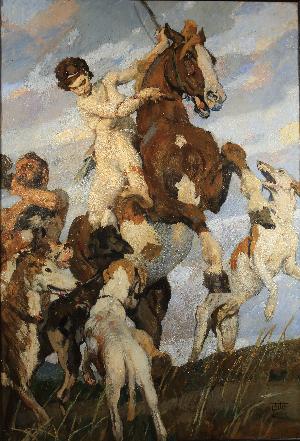TITO ETTORE
CASTELLAMMARE DI STABIA (NA) 1859 - VENICE 1941
Born in Castellammare di Stabia on 15 December 1859, alive. He had the Dutch Van Haanen as his first teacher in Naples, but he soon went to Venice where he studied with Pompeo Marino Molmenti. He exhibited his first painting, Pescheria old in Venice, at the Venice Biennale of 1887, a painting that was very successful and was purchased by the government for the Galleria d'Arte Moderna in Rome. Since then he has exhibited at almost all major Italian exhibitions. In Rome, in 1911, he gave religious painting a remarkable work by winning one of the great prizes for altarpiece with The Deposition of the Cross, which is now housed in the Museum of Buenos Aires. He frequently exhibited abroad: in Paris, Munich, Vienna, Budapest, London, San Francisco, Brussels, where in 1915 his painting La gomena (preserved in the Gallery of Modern Art in Rome), got the grand prix awarded to Italy. In 1919 he ordered a personal exhibition in Milan. A fortunate painter, he always had the favor of the public and critics for his easily understandable, clear art, without problems or torments. "Healthy and serene, his art ignores ugliness" (Ugo Ojetti). This absence of pain, that is, of the drama of life, spreads, according to some critics, an aura of superficiality on his painting. But the great technical skill, the happy ease, the rare virtuosity of the glimpses and the effects of light, the vivacity of the color and the choice of subjects always in the open air, have given Ettore Tito's work an unmistakable prestige. The great allegorical compositions by him were performed on frescoed walls and in these we note a strong Tiepolo inspiration. And also in his other works the influence of Venetian eighteenth-century painting is evident. Some of his works are: Broad horizon; Descent; Autumn, in the Gallery of Modern Art in Rome; Baccanale, in that of Milan; The birth of Venus; In the Lagoon and Triumph of Venice, in the Pesaro Gallery in Venice; Bocca di Papa, in the Civic Museum of Turin; Portrait of prof. Franco, in the Civic Museum of Verona; Nymphs and Chioggia after the rain, in the «Ricci-Oddi» Gallery in Piacenza; Bovi, in the «Paolo e Adele Giannoni» Gallery in Novara; Adam and Eve, in the collection of comm. dr. Guido Antonioli; The corsair, in that of cav. Giovanni Bianchi; Alleghe Lake and Sunday in Fobello, already in the gallery of comm. Paolo Ingegnoli; Fondamenta, owned by Dr. Giovanni Rasini; The wait, in the collection of comm. Mario Rossello of Milan; The drawing and The Walnut Peelers, both in London; Chioggia, in the Luxembourg Museum in Paris; In Laguna, in Budapest; The centaur; Round dance; Solitude; Samaritan; Old woman and child; From the "belvedere"; Country lane. Count Volpi di Misurata keeps L'Aurora in his gallery, as well as several portraits of family members. The dazzling frescoes in the Villa Berlin-gieri in Rome are also by Ettore Tito's brush. With the fresco on the vault of the Chiesa degli Scalzi in Venice, a large-scale work completed in 1933, he healed a painful war wound inflicted on the art and religious piety of the Venetians, who on 24 October 1915 had lost the admirable window opened into the sky by Giovan Battista Tiepolo's brush. Ettore Tito had the highest official recognition with his appointment as Academician of Italy in 1929, at the establishment of the Institute, among the first appointments proposed to the King by the Head of Government for the class of Arts.
©2015 ENRICO Gallerie d'Arte - All Right Reserved - P.IVA 00985970094 | Privacy Policy | Cookie Policy | Site Map

